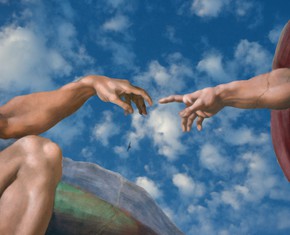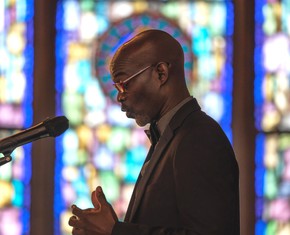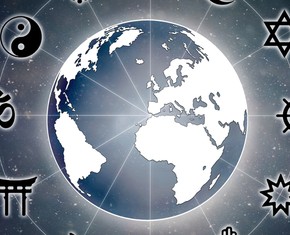The views expressed in our content reflect individual perspectives and do not represent the authoritative views of the Baha'i Faith.
You can find useful examples of scriptural huris or mysteries in two common allusions that have been the source of grievous consternation and conflict — one a statement by Christ, the other by Muhammad.
Christ called himself the “Son of God,” and Muhammad referred to himself as the “Seal” of the prophets. The inability of clerics and ordinary believers to understand the underlying poetic or symbolic meaning of these epithets, and thus comprehend their true significance, has generated untold conflict and confusion among followers of both religions.
RELATED: Did Jesus Foretell Muhammad?
Similarly, many mysteries or huris associated with the lives of all the messengers and manifestations seem beyond logic or reason. Christ mysteriously healed the sick and, according to Christian belief as inferred from biblical accounts, physically arose from the dead. Muhammad, though an unlearned camel caravan leader, became suddenly endowed with astounding eloquence after mysteriously receiving a revelation directly from God.
Using Logic and Reason to Unveil the Mysteries
What Baha’u’llah has made clear, in his discussion of “mysteries” in his principal Baha’i doctrinal treatise “The Book of Certitude,” is that the huris which have the most profound and often the most deleterious effect on the divine system of human education are misunderstandings about particular statements in the language of the prophets:
… they that tread the path of faith, they that thirst for the wine of certitude, must cleanse themselves of all that is earthly—their ears from idle talk, their minds from vain imaginings, their hearts from worldly affections, their eyes from that which perisheth. They should put their trust in God, and, holding fast unto Him, follow in His way. Then will they be made worthy of the effulgent glories of the sun of divine knowledge and understanding, and become the recipients of a grace that is infinite and unseen, inasmuch as man can never hope to attain unto the knowledge of the All-Glorious, can never quaff from the stream of divine knowledge and wisdom, can never enter the abode of immortality, nor partake of the cup of divine nearness and favour, unless and until he ceases to regard the words and deeds of mortal men as a standard for the true understanding and recognition of God and His Prophets.
RELATED: Why Do Religions Think They’re the Final Religion?
Baha’u’llah further explained that these mysteries are not meant to remain veiled or concealed, nor is their meaning available only to some esoteric class of scholars or learned clerics. Instead, like the parables of Christ, these passages are often symbolic or metaphorical expressions that have the intended effect of causing seekers or believers to think for themselves.
In fact, Baha’u’llah stated in the opening of this same discourse that the supposedly learned clerics and religious leaders are often the least capable of penetrating the literal surfaces of poetic scripture to discern their spiritual meaning — that these leaders are instead the greatest sources of literalism and orthodoxy.
Baha’u’llah wrote pointedly that the ability to decipher or “unveil” these huris or mysteries depends on purity of heart and sincerity of motive, not so much on academic prowess or learning that can be acquired from or imparted through the formal training so highly prized by clerics and divines.
One of the most obvious and weighty examples of the distinctive nature of this capacity occurs when Christ’s analogical explanations of spiritual concepts are easily understood by his unlearned disciples, but totally baffling to the learned Pharisees and Sadducees who plied him with theological questions. Likewise, it is the supposedly learned bishops who at the Council of Nicaea apply a literalist interpretation to Christ’s explanations of His relationship to God — “he that hath seen me hath seen the Father” (John 14:9) — and create the specious doctrine of literal Trinitarianism. This doctrine in which Christ is portrayed as God incarnate effectively undermines the entire notion of sequential and progressive revelations, a point that Muhammad repeatedly notes in the Qur’an in his discussion of the station of messengers versus the exclusive or incomparable station of God.
Ironically, the same sort of literalist interpretation of a single Qur’anic verse by later Muslim clerics would result in an equally flawed and perilous misunderstanding of the relationship of Muhammad and Islam to both past and future revelations. By interpreting Muhammad’s statement that he is the “Seal” of the Prophets as meaning that he was the final messenger from God and, further, that his revelation thus completes the revelatory process of the divine education of humankind on planet Earth, Muslim divines effectively duplicated the error of the Nicaean doctrine so hardily condemned by Muhammad. Instead of believing Muhammad to be the culmination of previous prophets, but coequal with them in station, they portrayed him as having a superior station, and Islam became wrongly perceived by many of its adherents as the final revelation from God intended to become spread throughout the world.
How Huris Work
If Christ did not mean that he is God, what did he intend by his statement that to know him is to know God? Likewise, if Muhammad did not mean that he has effectively sealed up or completed the process of enlightening humankind, what might he have intended by that verse?
Baha’u’llah himself utilized the first half of his “Book of Certitude” to explain this same subject — how to interpret or “unveil” the symbolic and metaphorical language of scripture. For as he explained, the inability of clerics and divines to comprehend the poetic or symbolic nature of scripture has been a major cause of much of the misunderstanding and conflict that has plagued religious history.
As a demonstration of how to unveil the symbolic and metaphorical meaning of scripture, Baha’u’llah explained how Muslims could have converted Christians to Islam had they understood how to explicate the symbolic meaning of Christ’s prophetic passages regarding his return. Baha’u’llah devoted approximately 100 pages of “The Book of Certitude” to demonstrating this point further. In it, he focuses on Christ’s allusion to his return in Matthew 24:29–31 and unveils the huris in these three verses, though he humbly characterizes this explication to be but “a dewdrop out of the fathomless ocean of the truths treasured in these holy words:”
This servant will now share with thee a dewdrop out of the fathomless ocean of the truths treasured in these holy words, that haply discerning hearts may comprehend all the allusions and the implications of the utterances of the Manifestations of Holiness, so that the overpowering majesty of the Word of God may not prevent them from attaining unto the ocean of His names and attributes, nor deprive them of recognizing the Lamp of God which is the seat of the revelation of His glorified Essence.
During the course of his examination of these verses, Baha’u’llah observes that he is uncovering the “inner meaning” of just one of a myriad such passages of scripture and other types of concealed wisdom:
How many the huris of inner meaning that are as yet concealed within the chambers of divine wisdom! None hath yet approached them;—huris, ‘whom no man nor spirit hath touched before.’
This passage alludes to Muhammad’s verse — Qur’an 55:54–56 — where the prophet describes the bounties that await those who ascend to paradise:
They will recline on Carpets, whose inner linings will be of rich brocade: the Fruit of the Gardens will be Near (and easy of reach). Then which of the favors of your Lord will ye deny? In them will be (Maidens), Chaste, restraining their glances, whom no man or Jinn before them has touched.
It is important to observe that Baha’u’llah here is not using the verse from the Qur’an to explain his own idea. Quite the reverse is true. He actually demonstrates the inner meaning of the huri of an often cited Qur’anic verse to prove the very nature of a huri itself. He explains the inner meaning of a verse commonly assumed by some Moslems to describe a physical reward in a literal afterlife — a verse that, according to Baha’u’llah, actually states symbolically that those who are faithful will be given insight to the inner significance of scripture and other verities that were veiled from them during their physical lives.
In short, Muhammad’s verse about mysteries is itself a mystery, a passage which anticipates the concept explained by Abdu’l-Baha in his writings:
When the human soul soareth out of this transient heap of dust and riseth into the world of God, then veils will fall away, and verities will come to light, and all things unknown before will be made clear, and hidden truths be understood.
But perhaps the single most weighty statement about the importance of understanding the inner meaning of the revealed word, or the “Book,” as scripture is often called in the Qur’an, is Baha’u’llah’s observation that the reading or recitation of scripture without understanding has “no abiding” value or merit, because the purpose of the revealed word is to teach us about reality. If we are to be meaningfully informed, then obviously we must first understand what is being said to us.
RELATED: The Cradle of Christianity—and Islam
Commenting explicitly in his “Book of Certitude” regarding those Muslims who recite and memorize the Qur’an without understanding it, Baha’u’llah made the following observation about the purpose of the scripture that constitutes the Qur’an:
Again and again they read those verses which clearly testify to the reality of these holy themes, and bear witness to the truth of the Manifestations of eternal Glory, and still apprehend not their purpose. They have even failed to realize, all this time, that, in every age, the reading of the scriptures and holy books is for no other purpose except to enable the reader to apprehend their meaning and unravel their innermost mysteries. Otherwise reading, without understanding, is of no abiding profit unto man.
During the course of the first 116 pages of “The Book of Certitude,” in which he unveils the prophetic verses of Matthew 24:29–31 regarding the signs of the coming of the Son of Man, Baha’u’llah also presents the reader with an exceedingly useful series of exercises in hermeneutics. Using these tools, he explicates various levels of symbolism associated with Christ’s prophecies, and demonstrates how Christ was preparing his followers for the advent of Muhammad.
In these explanations, Baha’u’llah again employs passages from the Qur’an at every turn to support his argument, and to underscore his explication of particular points. We should again be careful to note, however, that far from assuming that his elucidation of these Qur’anic passages are clear or obvious to his Muslim audience, Baha’u’llah is well aware that these explanations demonstrate the meaning of huris that would be equally veiled to literalist Muslim believers and clerics alike.
By placing these verses in the context of his argument about proofs of Muhammad as foretold in the New Testament, Baha’u’llah conversely uses the Qur’an as a means for justifying to Muslims the validity of the Christian scripture and, as Baha’u’llah demonstrates later, as a means of showing how the Qur’an and certain Muslim Hadith prophesize the advent of both the Bab and Baha’u’llah himself. He thus provided a cross reference for these critical passages for Christians, for Muslims, and, toward the final section, for Babis, those who followed his predecessor and herald The Bab.
This series of essays is adapted from John Hatcher’s book The Face of God Among Us, with the permission of the author and the publisher. To purchase the entire book, please click here.
















Comments
Sign in or create an account
Continue with Googleor